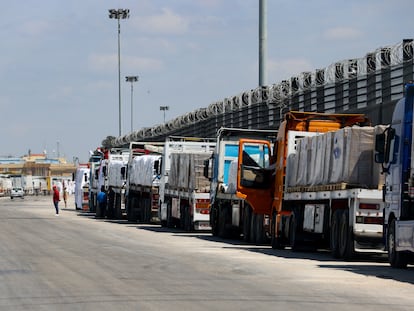Satellite images reveal extent of devastation in Gaza after six months of war
Nearly six in 10 buildings in the Strip have been damaged or destroyed by Israeli attacks and its largest medical complex is an ‘empty shell,’ according to the WHO
Destruction has reached every corner of the Gaza Strip. Satellite images of the Palestinian enclave show critical infrastructure in ruins, cities razed to the ground and the precarious conditions in which hundreds of thousands of displaced people are living. The map below highlights the buildings that have been damaged during six months of the Israeli offensive.
Up to 57% of buildings in the Strip have been destroyed or damaged, according to analysis carried out at the University of Oregon, but that figure rises to 75% in Gaza City. The capital of the Strip was the initial target of Israeli strikes in retaliation for the deadliest attack in the history of the Jewish state by Hamas militias on October 7, 2023. A comparison of satellite images taken before the conflict and today shows the devastation in the city, especially in the neighborhoods closest to the sea.
The detail of the photographs taken by the European Space Agency’s Sentinel-2 satellite reveals the scale of the tragedy. Al-Shifa Hospital, once the largest medical complex in the Strip, was besieged by Israeli troops for two weeks. It is now an “empty shell” of charred buildings, rubble, and corpses, as reported last Saturday by a World Health Organization mission that gained access to what remains of its facilities.
Over the months, the Israeli army expanded its offensive into the south of the enclave, where civilians had been forced to withdraw while Gaza City was under siege.
Four months ago, Israeli troops entered southern Khan Younis, the second largest town in the Strip. It had been singled out by the Israelis as Hamas’ stronghold. On Sunday, the Israeli military announced the withdrawal of ground troops from the area, in a move aimed at “recovering” in preparation for “future operations,” according to an Israeli military intelligence spokesman. The city has been razed to the ground, several residents who have returned after the Israeli withdrawal told Reuters.
More than 33,000 Palestinians have been killed since the start of the war, according to the Hamas-controlled Gazan Health Ministry. At least 13,000 were children, according to UNICEF. The destruction of health infrastructures prevents the civilian population from accessing the most basic medical care, medicines, or vital treatment. The following comparison shows the area around the main hospital in Khan Younis this April and in 2023.
In Rafah, the last Palestinian town before the border with Egypt, more than 1.4 million displaced people are crowded together, out of a total population of 2.2 million Gazans.
The situation of more than half of Gazans who are still alive is “catastrophic,” as international organizations pointed out two weeks ago. The entire population of the Strip is suffering from malnutrition, one million people have lost their homes, and two out of three have been displaced, according to a report by the U.N. and the World Bank. A large proportion of refugees live in tents on the outskirts of towns, as seen in this view of Rafah.
What were wastelands just a few months ago have become fields of tents. Such is the extent of the new camps set up by displaced Gazans that you can walk for miles around them. The white and blue tarpaulins under which Gazans seek shelter are visible from satellite images. Other details are visible at ground level, such as the conditions of the families who on Tuesday were preparing for the end of Ramadan.

Credits
Sign up for our weekly newsletter to get more English-language news coverage from EL PAÍS USA Edition

